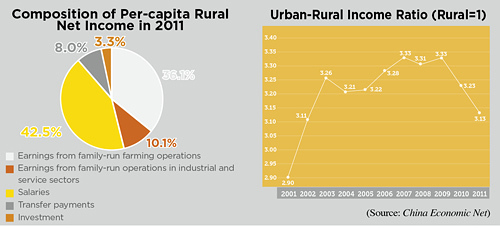|
China set up a new rural cooperative medical system in 2002. The system is co-paid by individuals, collectives and the government and voluntarily participated in by rural residents. As of the end of 2011, 97 percent of rural residents were covered by the system, according to the Ministry of Health.
In 2011, China raised annual per-capita medical subsidies to rural residents under the new rural cooperative medical system from 120 yuan ($19) to 200 yuan ($32).
In 2009, a new rural pension system was piloted in 10 percent of China's counties. The pension system is financed with funds from rural residents, the Central Government and local governments. Under the system, rural residents aged 60 years or older receive a minimum pension payment of 55 yuan ($9) per month financed by the Central Government.
Rural residents under 60 years old should pay at least 4 percent but no more than 15 percent of the local average per-capita income in the previous year for 15 years in order to be eligible for the pension after turning 60. The higher the premium they pay, the more pension they will be able to claim later.
In 2011, the new rural pension system was expanded to cover more than 60 percent of China's counties, and more than 100 million farmers are claiming pensions, reported Chinese Social Sciences Today, a Beijing-based newspaper.
Income from investment accounted for 3.3 percent of rural per-capita income in 2011. Last year, farmers also earned more from interest and dividends.
"Historically, there have always been strong driving forces behind fast growth in rural residents' income," said Liu Liren, head of the Agriculture and Forestry Department of east China's Jiangsu Province.
Liu has analyzed the income growth trajectory of rural residents in Jiangsu and identified four periods of fast growth: 1978-84, 1985-88, 1992-96 and 2004-present.
"The major growth engine in the first fast growth period was the implementation of the household responsibility system, which allowed farmers to independently manage their contracted land. In the second and third periods, thriving township enterprises under the reform and opening-up policy drove up farmers' income. In the current fast growth period, the migration of rural labor into cities, tax reforms and growing subsidies are major stimuli," Liu said.
As for how to further boost farmers' income, Liu suggested that while guaranteeing grain security and protecting the rural environment, farmers can develop more-efficient modern agriculture and rural tourism. He said that farmers should also be encouraged to run businesses and to become city dwellers, and county seats and big towns should be developed to accommodate more residents.
Liu Chunxiong, a professor at Zhengzhou University in central China's Henan Province, said that there are a few options for boosting farmers' incomes from agriculture, which include increasing the acreage under cultivation, increasing unit yields, raising agricultural product prices, and changing the crop structure and production methods.
"But there are limitations to some of these options. For example, although increasing the purchasing price for agricultural products will increase farmers' incomes, price hikes will push up the living cost of urban residents. Or some farmers may increase their income by switching from grain to more lucrative cash crops. But to ensure grain security, most farmers still need to produce grain," he said.
On average, every Chinese farmer only has a small acreage of land to work on. Official statistics show that per-capita arable land in China is 0.092 hectare, which is 40 percent of the global average.
Worse still, the total area of arable land in China has been dwindling, and the room to expand the acreage is limited.
In response, the Central Government's first policy document for 2012 underscores the importance of scientific and technological innovation for sustained agricultural growth.
Li Yining, a renowned economist, recently suggested that farmers should be given property rights to encourage them to transfer or lease their land and homes to others. He believes that land should be operated by efficient planters, agricultural cooperatives specializing in certain products, and agricultural companies with advanced technologies.
He said that the social safety net should cover both urban and rural residents adequately. Otherwise income redistribution will widen the urban-rural gap.
Li also said that education resources for urban and rural schools should be balanced because education inequality will breed income inequality in the next generation.

Email us at: wanghairong@bjreview.com | 